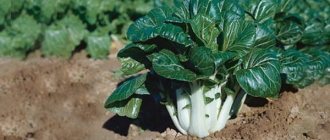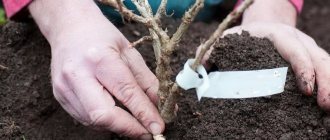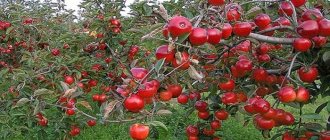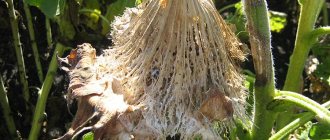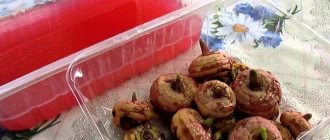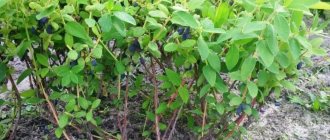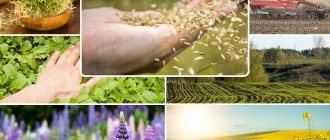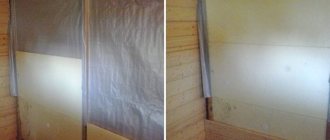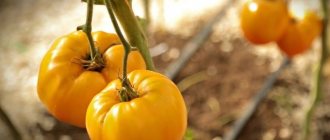How do you know when it’s time to harvest sunflowers?
Determining the maturity of a crop is carried out by a specialist - an agronomist-technologist. But even without special knowledge it will not be difficult to do this. The maturity of sunflower is determined by external signs:
- the petals dry out and fall off, and the head bends down;
- the back side of the seed head changes color from yellow to brown;
- the seeds swell and protrude slightly from their “cells”;
- the kernels in the achenes take on the varietal color and harden.
A mandatory measure for monitoring crop ripeness is measuring the moisture content of the baskets and seeds. This indicator varies depending on the phase (level) of maturity:
- yellow phase - basket humidity is from 85 to 88%, seeds - from 30 to 40%;
- brown phase - the moisture level of the basket is in the range of 40-50%, and the seeds - 10-12%;
- full ripening - head moisture is from 18 to 20%, and seeds - 7-10%.
Start harvesting when more than 80% of the planted sunflowers enter the brown phase. Please note that the optimal moisture content of seeds intended for long-term storage is 9-11%.
If the farm has drying equipment and it is impossible to wait for harvesting work due to weather or other conditions, you can start harvesting sunflowers when the seed moisture content is no more than 20%.
Determine the timing correctly
The ripening time of the fruits of any agricultural crop depends on its variety and natural conditions. Sunflower is no exception. Many early and late varieties and hybrids are grown in the fields of Russia and Ukraine.
Thus, the Rodnik and SUR varieties are distinguished by a short growing season - about 80 days and high oil content. These varieties in the southern regions can be sown twice per season - in May and mid-July.
For early ripening varieties Yenisei, Buzuluk and Cruise, the growing season lasts about 90 days. Early ripening Kazachiy, Donskoy-60, Berezansky and VNIIMK-88883 ripen in 80-86 days, they tolerate adverse weather conditions well and are suitable for growing in the Southern Urals and the Volga region.
The main indicator of the ripeness of seeds is their moisture content, and this is what people pay attention to first before harvesting.
As a rule, sunflower seeds are filled 35-40 days after flowering, at which time their humidity reaches 40%; experts call this stage physiological ripeness. After which the accumulation of useful substances stops, and then, after the humidity decreases to 20% and below, it stops completely. This is already the period of economic ripeness.
Moisture loss occurs due to evaporation and depends on air humidity and winds. In areas with a hot and dry climate, moisture evaporates 2-3 weeks after physiological ripeness, and then the seed moisture content is 12-14%, ideal for harvesting. In regions with humid summers, this process lasts up to 4-5 weeks, the humidity is higher - up to 18%.
Another criterion is the ripeness of the baskets. Their condition and color accurately indicate the moisture and maturity of the seeds. Through many years of observations, it was found that the highest harvest can be harvested when 70-80% of the baskets turn brown and dry, and the rest turn yellow. At the same time, the moisture content of the seeds is 18-20%.
Experts determine three degrees of sunflower ripeness:
- yellow - when the back side of the basket turns from green to lemon yellow, and the seeds reach their maximum development and have a moisture content within 40%;
- brown, when the basket and leaves around it dry out and become brown, the seed moisture content is 10-14%;
- complete when the plant dries completely and the moisture content of the seeds is 7-10%.
The fewer plants with yellow heads on the field, the higher the yield and quality of the seeds. But you shouldn’t delay harvesting too much - if the sunflowers sit too long, the humidity will drop to 7-8%, and the yield will also suffer. This is especially important for dry steppe regions. In addition, dry seeds quickly fall off and are crushed during threshing; birds, squirrels and small rodents cause significant damage.
Farmers in the northern regions have their own problems, one of them is high air humidity and frequent rains. The optimal seed moisture content for combine harvesting is 12-14% only if the autumn is dry. Typically, oilseed harvesting here begins at a seed moisture content of about 18%, and sometimes at 20-22%. Timely cleaning is also important because it allows you to protect ripe baskets from white and gray rot.
Experts have established the following harvesting times for regions with different climatic conditions: in the Volga region, the Central Black Earth region and the forest-steppes of Ukraine, the harvest must be harvested in 8-10 days, and in Moldova and the North Caucasus - within 5-7 days.
To meet these deadlines, it is necessary to carry out preparatory measures - to put harvesting equipment, transport, and premises for cleaning and drying seeds into working order.
Sunflower harvest time
Timely harvesting of sunflowers minimizes seed loss and prevents their spontaneous combustion during storage. To determine the harvest period and the exact date of its beginning, take into account the moisture content of the crop and the availability of economic equipment.
The minimum humidity for harvesting is maintained only in the Southern regions; in colder climate areas, harvesting begins when the sunflower humidity is from 12 to 14%.
Weather conditions have a particular impact on harvesting times. Here it is worth assessing the risks and costs of moving the harvest date to an earlier or later period. To quickly ripen seeds in rainy autumn, it is advisable to use special means.
An important condition for pre-harvest work for the farm is the preparation or purchase of special equipment. Household equipment directly affects the duration of sunflower harvesting. There is no need to save on technology, because the capacity should be enough to finish the harvest within 6 days.
Delaying the timing of sunflower harvesting will lead to overripening of the crop and a sharp increase in losses due to dryness and fragility of the stems, natural shedding of seeds, their damage by rot, as well as due to the activity of pests (birds and rodents).
Sunflower desiccation
On a note. Sunflower harvesting, which is carried out at the stage of full maturity of the crop, is distinguished by its effectiveness. The period is characterized by the end of oil accumulation, the hardness of the kernels, and the acquisition of the appropriate color.
But often, in unfavorable climate conditions, the seeds do not have time to ripen; the humidity is 25%. Pre-harvest drying, or desiccation of sunflowers, is aimed at accelerating the ripening process. Treated with desiccant for sunflower in dry weather:
- aedile;
- reglon;
- magnesium chlorate;
- glyphosate.
Glyphosate-based chemicals are intended for seed crops and are designed for long-term use. The drugs are used mainly 14 to 28 days before harvest. Crops dry out gradually, so diseases affect the sunflower head for a longer period of time and reduce the quality of oil seeds.
Products containing glyphosate have a systemic effect on crops. This active substance is not suitable for seed sowing - penetration into the seed embryo reduces energy and germination.
Sunflower desiccation
When sunflower is desiccated, the timing of seed ripening is reduced, and the following is also noted:
- simultaneity of crop maturation;
- earlier start of sunflower harvesting – a week;
- increasing productivity;
- quality of seeds with a maximum humidity of 9%;
- reducing harm from plant diseases;
- increase in oil yield per 1 ha;
- increased productivity of combines, reduced energy costs.
Conditions for desiccation:
- Carrying out an operation when changing the color of baskets to brown, one and a half weeks before harvest.
- At crop humidity of 25-30%.
- Application of recommended pesticides.
- Compliance with technology.
- Correct calculation of herbicide dosage.
- Spraying oilseed plants if it is dry and sunny outside, in the morning.
- Carrying out threshing of sunflower 10 days after desiccation.
The optimal humidity of collected seeds does not exceed 7% and affects the duration of storage.
If you collect seeds with high humidity, this threatens oxidation and makes sunflower oil unsuitable for consumption in food.
On a note. When growing sunflowers for dietary and baby food, plant desiccation is not used.
Treatment with desiccants
Desiccants are preparations that ensure earlier and faster ripening of sunflowers, thereby guaranteeing increased productivity and high-quality harvesting. Desiccation technology allows you to bring the harvest closer by 5-7 days, thereby gaining time and getting additional profit.
The application of the drug during the brown phase of development reduces the incidence of the crop. Phomopsis, gray and white rot develop quickly precisely at the moment of filling sunflower seeds. Desiccation dries out the crop and stops the disease.
The treatment helps control weeds - stopping the growth of ragweed, white pigweed, sow thistle and acorn grass. This is especially true if the weed is taller than the main crop.
The effectiveness of desiccation is determined by the correct choice of drug and its concentration, so be sure to read and follow the instructions for use of the product.
Farmers use three types of desiccants, based on:
- isopropylamine and potassium salts of glyphosate - “Tornado-500”, “Tornado-540”;
- diquata - “Sukhovei” and “Reglon Super”;
- ammonium glufosinate - "Basta".
Treating sunflower with desiccants cannot be done using self-propelled sprayers - the crop losses are too large. Therefore, provide air handling. Be sure to check the spray setting and water flow. The water consumption rate is at least 80-100 l/ha, and the drug itself is added according to the instructions (usually 2 l/ha).
Plan treatment with drugs in cloudy weather or in the evening, as the active substance is destroyed in the sun. 50-70 minutes after treatment, the composition is completely absorbed by the leaf plates and begins its beneficial effect.
What is desiccation?
To reduce the moisture content of the seeds while still in the field, the plants are treated with desiccants, that is, they are desiccated. This event is necessary if the autumn is rainy, the moisture content of the seeds is quite high and does not decrease naturally.
Desiccation of crops is treatment using aviation. The fields are sprayed from the air with special chemicals - desiccants at the rate of 100 liters of solution per hectare. Desiccants are most effective at an ambient temperature of 13-14 degrees.
Desiccation must be carried out within a certain time frame: premature treatment reduces yield, late treatment turns out to be useless. However, the effect of weather on plants cannot be completely excluded. After spraying the crops, harvesting begins taking into account weather conditions that affect the drying of the seeds.
Magnesium chlorate, Reglon and mixtures of them are most often used as desiccants.
Magnesium chlorate is highly hygroscopic, slow and mild in action. It dissolves well in water, easily penetrates leaf tissue and begins to act within an hour after spraying. But the influx of organic matter into the seeds continues for another 3-4 days, whereas after treatment with Reglon this process stops within 24 hours.
The drying process of seeds occurs at different speeds, which depends on weather conditions, but also on the initial moisture content of the seeds. Seeds with initially low humidity in the range of 20-22% reach a state of economic ripeness faster; as a rule, this takes about a week. Seeds with a moisture content of 30-35% will reach the desired condition in 10 days.
Sunflower treated with desiccants must be harvested in a short time - 5-7 days, otherwise serious losses cannot be avoided due to shedding and severe crushing during threshing.
It is better to spray large fields with insufficient special equipment in two steps to prevent delays during harvesting.
Desiccation, which inhibits the natural processes of seed filling, slightly reduces the yield of crops, but at the same time makes it possible to reduce losses by speeding up the harvesting time, reduces the cost and speeds up subsequent drying.
Desiccation not only reduces the moisture level of seeds, but also serves as a good preventive measure to protect against gray and white rot. If there is a threat of infection and disease development, treatment is carried out earlier at a seed moisture content of 36-38%. In this case, seeds that do not have time to fully ripen will be less valuable and productive, but these losses will be covered by possible losses from the disease. Desiccation is carried out if rot has affected about 10-12% of the plants.
If the rot is not so widespread, you can wait until the moisture content of the seeds drops to 30-35%.
In cases where the disease has spread very strongly, treatment with Reglon is allowed at a seed moisture content of 40-45%. This stops the disease and helps protect the crop from destruction.
If desiccants are used correctly and in the right quantities, they do not accumulate in the seeds and oil, or are contained in acceptable concentrations. And yet, for the preparation of dietary and baby food products, oil from plant seeds that have been treated with desiccants is not used. Products grown in the southern regions are used for these purposes, where sunflower is fully poured and dried on the field under the influence of the sun, without magnesium chlorate and reglon.
Harvesting methods
Sunflower harvesting is carried out using grain combines such as “Polesie”, “Neva”, “Don-1500”, equipped with special headers. Such attachments are adapted for cutting crop heads at different heights, including laid down plants.
Reapers are an agricultural tool that can expand the capabilities of harvesting equipment and make it highly efficient. Their standard indicators:
- residual stubble height - no more than 20 cm;
- in the bin the heap purity is not lower than 95%;
- seed loss – up to 2.5%;
- grain crushing - no more than 1%.
When purchasing tools for sunflower harvesting, know:
- The size of the nozzles is selected according to the dimensions of the harvesting machine. The minimum width of the header is 4 meters. The larger the size of the device, and therefore its weight, the greater the fuel consumption, but the shorter the cleaning time.
- The header is secured to the combine body with special flanges. The design may include a hydraulic system that serves for vertical adjustment of the header by the combiner directly from the cab. This saves time, preserves the worker’s physical strength, but requires additional knowledge. Nozzles with a mechanical drive shaft are economical and easy to maintain.
- Often a tray is included with the header to reduce natural crop losses. If the package does not include it, order a pallet according to individual parameters or purchase it separately.
A modern header allows harvesting in all areas of the crop field, regardless of weather conditions. Thanks to her, the work goes smoothly and quickly, and losses are insignificant.
It is unacceptable to use grain headers for sunflower harvesting because they are unsuitable for this type of work. Due to an unsuitable reel, high seed loss will occur during harvesting.
The solution in such a situation would be to purchase a special attachment - a lifter. Universal models are suitable for various types of cleaning equipment, are easy to use and do not require maintenance.
The technology for harvesting sunflowers is similar to harvesting grain crops. It provides:
- Cutting the field and dividing it into rows 2-3 days before the combines enter.
- Organization of roads and entrances for equipment.
- Sunflower mowing with headers.
- Stubble burning.
Proper and timely organization of the harvesting campaign will allow the work to be carried out efficiently and quickly, so do not neglect the preparation of equipment and other activities.
Cleaning
Sunflower diseases
On a note. Sunflower harvesting is carried out at the stage of economic ripeness when the number of unripe yellow heads is within 12%, the rest are dry. The plants are completed within a week.
12-14% humidity signals the start of harvesting in hot climate regions. In areas with an unfavorable climate, the process is delayed for up to a month, the humidity reaches 18%. Total sunflower losses do not exceed 3%, but are possible if harvesting is delayed. Delaying deadlines doubles losses from self-destruction.
The yield of oilseed crops is determined by:
- hybrid or variety;
- climatic zone;
- weather;
- type of soil.
1 hectare brings a minimum of 18 and a maximum of 40 centners of seeds. However, the average figure in the agricultural sector, for example, in the Krasnodar Territory, is 26.4 c/ha. The sunflower yield parameter varies by region:
Harvest occurs in the first ten days of August
- 35 c/ha – Bryansk region;
- 12.8 c/ha – Samara region;
- 10.9 c/ha – Altai Territory;
- 21.1 c/ha – Rostov region;
- 10.4 c/ha – Orenburg region;
- 13.3 c/ha – Volgograd region.
Attention! Experts say that sunflower yields in the Russian Federation as a whole are decreasing compared to the indicators of past years.
Negative dynamics are visible due to the cultivation of oilseeds in areas with an unfavorable climate without the use of zoned varieties.
Harvesting occurs in the first ten days of August and ends at the end of November, before the snow falls. The time depends on the variety. Some farmers begin harvesting sunflowers before the onset of winter due to the optimal seed moisture and good keeping quality. It is important to monitor for mold, which contributes unappealing aroma and acidity.
Features of agricultural technology for harvesting oilseeds:
- seed losses do not exceed more than 2.5%;
- stubble height – 20 cm;
- during threshing heads and cleaning seeds on the separating working bodies, the number of injured individuals is limited to 1.5%;
- crumbling and collapse of grain when threshing for seeds - maximum 1%;
- clean heap in the bunker - 95%.
On a note. The difficulty of harvesting raw materials is determined by the structural features of the crop.
Sunflowers have a high stem, which often grows up to 230 cm and creates the need to process plant mass up to 120 c/ha with different levels of humidity.
When sunflowers are picked is difficult to determine with certainty down to the day. They are harvested at a humidity of 14% in a semi-raw state and stored in a warehouse with a grain thrower. Wait 1 or 2 months until the seeds peel off on their own.
The methods for collecting sunflowers in the fields include both mechanical and manual. In the first case, a grain combine is used, equipped with a special header.
Manual cleaning structures
Sunflower harvesting is carried out at the stage of economic ripeness
On a note. If it is not possible to use specialized equipment at the dacha, gardeners use manual tools for harvesting.
The principle of operation of the device, how to get seeds from a sunflower, is to hit the cap and knock out the seeds. Variations of hand harvesters are popular among summer residents:
- Rotisserie. Suitable for farmers who are engaged in the cultivation of sunflower on a mass scale - for oil in order to benefit. The spit is used on 10-20 acres of vegetable garden. The mechanism will require a 200-liter metal barrel and a welding machine. Thresholds are welded inside the container for contact with the sunflower when the apparatus is turned. Holes are made on the sides of the barrel for pouring out seeds. The hats are placed in a barrel and the device is turned. The device works effectively when the harvest is dry and the relative humidity is 6%. The grain saturated with moisture is difficult to knock out. Some farmers light a fire under a barrel or place a heating element. In this way it is possible to obtain toasted or dried seeds.
- Stool leg. An effective tool for a garden bed where a couple of dozen crops grow. Such a “reaper” does not require any expense; anyone can easily prepare it or find it in the barn. The stool leg has the required mass and shape to hit the sunflower cap. There are 2 methods to harvest the crop. A bag is pulled over the sunflower's cap and blows are applied. 10-15 manipulations are enough for the seeds to end up in the bag. Another method involves cutting the sunflower caps into one place, then knocking out the seeds while sitting. The method is suitable for those who want to collect seeds conveniently and simply.
- Polyethylene. Some summer residents prefer the old-fashioned methods - stick and oilcloth. Similar to the previous technique, but deals with 15-20 crops. Plastic film is spread on both sides of the row. The summer resident passes and knocks out the heads. The device is moved further along the length of the row and the procedure is repeated. The seeds are selected and poured into a bowl.
- Bag. The crop heads are cut off and placed in a large polyethylene bag. When filling the bag, knock it out for at least 5 minutes with a stick (shovel holder). Then they untie the bag and take out the empty hats. To get rid of debris, the raw materials are blown under a fan.
Storage
On a note. Harvested seeds are capricious to storage conditions. Their high humidity is the root cause of self-heating and the development of microbes after two hours in the mass, which is left unattended. The phenomenon is very dangerous if it is hot outside and the seeds are clogged.
The shelf life of raw materials during storage is determined by the integrity of the coating. Damaged seeds lose mechanical protection against the penetration of microorganisms. It is noticeably weakened by the presence of weed impurities in the mash, which is more hygroscopic compared to seeds.
Summer residents are interested in how they can preserve sunflowers after cutting. Storing sunflower seeds for long-term storage depends on the contamination level, which is a maximum of 2%. The raw materials are dried and cooled to a temperature of no more than +10 °C. Shelf life – 6 months.
Seeds are stored:
Harvested seeds are capricious to storage conditions
- creating an embankment up to 1 m, with a seed moisture content of 7-8%;
- in bags, forming 6 tiers, with 10% maximum humidity;
- in ventilated barns after preliminary cleaning and good drying.
On a note. If sunflower seeds are affected by white or gray rot, they are collected early and must be heat treated to dry the material.
Storage of 99% peeled seeds with a moisture content of 7% is carried out in a dry place. Storage conditions: relative air humidity – 60%, minimum temperature – 25 °C. You cannot store seeds for a long time in an unsuitable room due to hygroscopicity and oxidation of the oil.
Proper storage of sunflowers
Sunflower is very demanding on storage conditions, so if you cannot meet them, it is advisable to use the services of special warehouses and elevators.
Optimal conditions for storing seeds indoors:
- constant ventilation;
- humidity - 7%;
- air temperature - 7-10 °C.
Before being sent for storage, sunflower must be subjected to primary cleaning using the ZAV-20 complex or other similar units; additionally treated with secondary and final cleaning systems SVU-5, SM-4; calibrate on pneumatic sorting tables PSS-2.5, BPSU-3.
This must be done because:
- Sifting seeds removes illiquid empty seeds, debris and weeds from the bulk. The final contamination should not be more than 2%.
- calibration involves separating the seeds into planting material and those that will be sent for processing.
- Drying prevents rotting and increases the shelf life of sunflowers.
When drying seeds, follow fire safety rules. During the procedure, the seeds rub against each other, as a result of which microparticles of the husk enter the air. Their high concentration can lead to fire.
If preparatory work is not completed and storage conditions are not observed, the crop will die. All the money and effort spent will be in vain, because:
- The oil in the kernel of the achene can oxidize. Such a crop is not suitable for processing into oil due to its high acid content, and it is also not suitable for sowing.
- High temperatures and high humidity indoors lead to the spread of sunflower diseases. The seeds become unusable at all. In addition, as a result of the proliferation of microorganisms, sunflower not only loses its properties, but can also spontaneously ignite.
Store grain intended for the food industry in fabric bags placed on wooden pallets in groups of 6-8 units. Seeds for this purpose should not contain chemicals.
Place sunflowers that will be used for sowing next season in bulk in a bunker or send to an elevator. Check its humidity and temperature periodically to prevent problems from occurring in time. Do not forget to disinfect the room before adding seeds.
The maximum shelf life of sunflower, subject to all conditions, is 6 months.
Start harvesting, taking into account the maturity and moisture content of the seeds. To shorten the time, use desiccants. Harvest using combines with seed attachments or lifters. Do not neglect the work on preparing seeds for storage and observe the necessary conditions in bunkers and elevators. And then the harvest will bring you profit!
0
1
Copy link
Growing conditions and care
In order for the plantation to ensure good yield and high profitability, you need to adhere to certain rules for planting sunflowers and subsequent care of the plants. The farmer must choose the right site with the appropriate soil type and lighting, follow the recommendations for crop rotation, and provide the plantings with a sufficient amount of water and nutrients.
The place of sunflower in crop rotation
Experts note that this crop is particularly demanding in terms of maintaining the sequence of growing certain agricultural plants on the site. This is explained by 2 key factors - the volume of residual water in the soil and the presence of various infections in it.
The optimal predecessors for sunflower are any grain crops. It can be safely planted on fields that were previously used for growing spring and winter cereals, corn, etc. Areas where sugar beets, perennial grasses and other crops whose roots can penetrate deep into the soil were grown in previous seasons are not suitable for sunflower plantings. After them, water reserves in the soil are significantly reduced. Also, in the fields where you plan to plant sunflowers, any oilseeds, broadleaf plants and representatives of the cruciferous family, as well as a number of nightshades and legumes, should not have been grown in previous years. All of them are susceptible to diseases common to sunflowers, which can remain in the soil.
In addition, you should not use the same area over and over again. Scientific research and practical experience show that it is possible to return sunflowers to their previous plantation after 5-6, and in some cases 9 years. This is necessary to prevent the accumulation of pathogens of infectious diseases and broomrape seeds in the soil.
Soil requirements
The most suitable for growing sunflowers are slightly alkaline or neutral chernozem soils. Forest chestnut and gray are also suitable. It is better to give preference to clay soils. Avoid acidic and saline areas, sandy or clayey soils - they will not yield high yields.
Soil treatment
- A maximum of 2 weeks before autumn plowing, when perennial weeds have already grown, the area is treated with glyphosphates.
- To minimize moisture loss in summer, it is worth treating the vacated field with a disk hoe after harvesting.
- Direct plowing of the field can begin after the soil reaches physical ripeness. The recommended plowing depth is 25-30 cm.
- For arid regions, the main plowing can be replaced by flat-cut cultivation to a depth of about 15 cm.
- In some cases, it is possible to use the technology of non-moldboard cultivation: the area is loosened with chisel plows that penetrate 30-35 cm into the ground, and then leveled with a disc harrow.
- Immediately before sowing, the field is subjected to minimal impacts: in early spring it is harrowed and then processed with a cultivator in 1-2 steps.
Fertilizers
Sunflower responds well to fertilization, resulting in a significant increase in yield. You can add both mineral fertilizers and organic additives. According to research, when rotted manure is applied at a rate of 20-40 tons per hectare, the yield increase is from 2 to 5 centners per hectare. The effectiveness of adding minerals directly depends on the agrochemical parameters of the soil, the required yield, the varieties used and other factors.
On average, to obtain 20 centners of harvest from 1 hectare of crops, the following is required:
- 22-24 kg phosphorus;
- 30 kg potassium;
- 55-58 kg nitrogen.
Fertilizers should be applied during the autumn preparation of the field or locally in the spring before planting sunflower seeds in the prepared area. Spreading phosphorus additives for spring cultivation will be ineffective. An important point: you should not allow an overdose of fertilizers, primarily nitrogen ones: in this case, the oil content of the seeds and the plants’ resistance to diseases and lack of moisture are reduced.
Nutrient consumption occurs at different rates depending on the stage of plant development. The main volume of phosphorus and nitrogen is used during the formation of the root system, stems, and green mass. A sufficient amount of potassium is important throughout the growing season - but it is most actively consumed before flowering begins.
Pre-treatment of seeds
To increase future yields, you need to know how to properly prepare sunflower seeds before planting them in open ground. Here is a list of basic preparatory measures:
- sizing – different sized seeds require different sowing depths and produce plants with different characteristics;
- sorting - you need to remove all low-quality seeds (sick, moldy), since they are unlikely to sprout normally and can also become carriers of diseases;
- dressing with fungicidal and insecticidal agents;
- treatment with growth stimulants - this procedure will accelerate the germination and overall development of plants.
Additionally, to increase germination, germination technology can be used. Here's how to quickly and efficiently germinate sunflower seeds:
- a suitable free space is prepared;
- then it is covered with a substrate that will retain moisture;
- the substrate is wetted with water;
- seeds are placed on top;
- then they are covered with a second layer of substrate.
Germination requires a temperature of at least 10 degrees and effective ventilation - otherwise the seeds may dry out and become moldy. Typically, the entire process takes about 48 hours.
Direct sowing
The hybrids used today with a high oil content and thin shells are more sensitive to temperature conditions. Therefore, planting seeds of such sunflowers in open ground should begin only after the soil has warmed up sufficiently. The control value can be considered a temperature of 10-12 degrees at a depth of 8-10 cm. Compliance with this condition will ensure rapid and effective germination of sown seeds, and in the future more uniform development of plants and increased productivity. If you sow the seed fund too early, the germination time will increase, and germination often also decreases. All sowing on the site should be carried out within 1-2 days.
Planting density should be determined in accordance with the soil moisture supply:
- in steppe regions, by the time of harvesting, no more than 45,000 plants should grow on 1 hectare;
- for areas with good moisture, a density of up to 50,000 plants per 1 hectare is allowed.
If the choice was made in favor of early ripening hybrids, then the planting density can be increased to 55-60 thousand plants per 1 hectare.
Nominal seeding rates are adjusted depending on the weed control method used. If herbicides are used, the recommended density is increased by 10-15%. With mechanical removal of weeds, the increase can be up to 25%. However, you should always take into account the reaction of the selected variety to an increase in standing density. Taking into account all amendments, average sowing rates reach 60,000 seeds per 1 ha. In most cases, pneumatic seeders are used for planting.
You should also know at what depth and at what distance from each other you need to plant sunflower seeds. The sowing depth depends on the individual parameters of the soil and seed fund:
- for normal soils – 6-8 cm;
- for heavy soils with sufficient humidity – 5-6 cm;
- with a lack of moisture – 8-10 cm;
- small-seeded varieties - 4-5 cm.
The distance between plants should be from 60 to 100 cm, depending on the height of the stems and the size of the flowers.
Aftercare
When all the seeds are sown, care must be taken to retain moisture in the field. Rolling with ring-spur type rollers is suitable for this purpose. This treatment ensures more effective contact of the planting material with the soil and promotes the rise of water.
In the initial stage of growth, sunflowers are very sensitive to competition from weeds. Therefore, you need to remove them regularly. The optimal method is mechanical weeding using a spring harrow and cultivating the spaces between parallel rows. Herbicide treatment is also allowed, but this procedure can be quite expensive. It is used, as a rule, by large farms with a large amount of available funds.
To increase the water and air permeability of the soil, it should be treated with cultivators.
Pest and disease control
Sunflower plantings are affected by numerous diseases and pests. The most common diseases include the following:
- downy mildew;
- rot of various types - coal, gray, white;
- brown, black and gray spotting;
- stem blight;
- verticillium wilt;
- ascochyta;
- rust.
The causes, symptoms and methods of control for each of these diseases are individual. The effectiveness of treatment largely depends on the efficiency and accuracy of diagnosis. Therefore, it is strongly recommended to have employees of the appropriate profile on staff or the opportunity to contact third-party specialists.
The main pests of sunflower are various insects. Harm can be caused by both adults and their larvae. Moreover, almost all parts of the plant can be affected - from the roots to the baskets with seeds.
What to clean
The sunflower harvest can be harvested using a conventional grain combine with a special header. Approximately three days before the start of work, combines make a double or triple walk around the field, after which the area is divided into sections, taking into account the daily norm for 1 unit. The quality of harvesting depends on the combine operator. The operator carries out work to minimize losses, checks all components and mechanisms of the machine.
Continuous monitoring should include the condition of the crop in front of the harvester, checking the raw materials in the bunker and the amount of losses, and monitoring the operation of the devices. The amount of losses must be monitored every hour of operation of the equipment. To do this, you need to stop the car and walk along the harvested strip, counting the number of uncut plants and fallen seeds. The cleanliness of the seeds in the combine bin is checked visually.
Sunflower yield - what you can count on
Many people think that getting 4 tons per hectare is something fantastic and requires incredible effort. In fact, sunflower is a very responsive crop that responds well to agricultural practices and fertilizers, and it is quite easy to grow record yields for our area.
The average yield in a temperate climate zone is 23 c/ha. Mid-early varieties produce a little less, their yield does not exceed 17-18 c/ha, in some cases it is possible to achieve 35-40 c, but this is mainly in breeding areas. Late varieties have a slightly higher rate - on average 25-28 c/ha, in some cases they give 45-50 under the condition of normal field cultivation. Varieties and hybrids also have a big difference in the average. The average yield of late varieties is 28 c/ha, while hybrids outperform them by 10-15% and give an average of up to 33 c/ha.
In order to collect record harvests and get large and full seeds, you must adhere to the basic rules of a gardener. Let's take a closer look at them.
- Timely sowing. Never plant grain in cold soil, as the plant will slow down in growth and this will greatly affect its subsequent yield. It is necessary to place the seed in heated soil (at least 15 degrees). This is the only way to expect a significant increase in mass during harvesting. Also, do not delay sowing, since sunflowers do not like heat. Planting at the end of May might just kill it. By the time the air temperature is +25-30 degrees in the shade, the plant should completely cover the ground with its leaves and retain moisture. Its root reaches 2.5-3 meters in depth and will nourish the stem even in the hottest heat.
- Correct fertilizer application schedule. When sowing, 100 kg/ha of phosphorus nitrate and superphosphate are applied. After the plant is 30-35 centimeters in height, it is necessary to apply foliar fertilizing with urea (the dose of each drug is indicated on the package), only then the sunflower yield per 1 hectare can reach 45 or more centners. Another feeding is carried out a month later, when the sunflower has fully formed its head, just before flowering, in order to gain as much weight as possible.
- Proper agricultural work. Be sure to plow the field to a depth of at least 25 centimeters in the fall , then do at least 2 cultivations (preferably 3), and after planting the sunflowers, treat the area with rollers and compact the soil, at the same time leveling it. It is necessary to treat with herbicide against weeds, and also to hill up the rows at a time when the plants are 40-70 cm in height in order to give more oxygen to the root system.
By fulfilling these simple requirements, you can count on record harvests and easily collect 40, 50 or more centners per hectare. Next, it is necessary to preserve the seed harvest and use highly efficient harvesters and equipment for harvesting.
